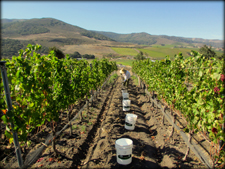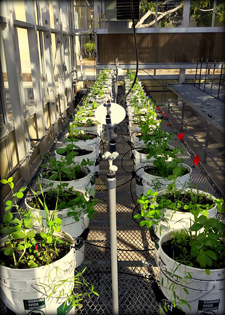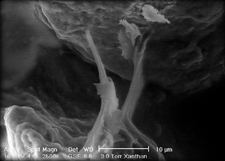Using soil exopolysaccharides to make California crops more drought adapted
Summary:
California’s recent drought, combined with climate change forecasts, indicate that California agriculture must adapt. For example, to support rapid expansion of grape vineyards, water conservation strategies that work from the “ground up” are needed. This research examined a soil-based solution for drought adaptation. If water retention and nutrient availability can be improved in dry soils, it may be possible to conserve large amounts of water by reducing irrigation frequency. Various synthetic soil surfactants and hydrogels are commercially available to increase water infiltration and retention, but these products can have toxic effects and are not intended to increase nutrient diffusion.
As an alternative, we amended vineyard soils in the greenhouse with an exopolysaccharide (EPS), xanthan gum, which is naturally secreted by soil bacteria, commercially available in bulk quantities, and a non-toxic FDA-approved food additive. When mixed with soil, xanthan is known to act as a “sponge” for long-lasting water retention and “pipes” for the diffusion of resources. However, there are no studies that have investigated the potential benefits of soil EPS on plants. Grape vines were grown with varying levels of xanthan and water to see whether soil EPS can maintain nitrogen supply and plant health while reducing the need for irrigation.
Investigator:
Joseph Blankinship
Assistant Researcher, Earth Research Institute & Dept. of Ecology, Evolution & Marine Biology, University of California, Santa Barbara
Project description:
California is in a predicament. Grape production for wine and food is more popular than ever, generating $4.9 billion annually and 40% of the world’s grapes. Grapes are now the second most important commodity in California. At the same time, California just experienced arguably its worst drought in recent history. And, on top of that, future climate change is expected to increase the frequency of drought. Therefore, California agriculture will only be sustainable by adapting to water scarcity.
Water conservation is an obvious strategy for making agriculture more drought-adapted. By irrigating less, water can be saved for when it is really needed. For example, by improving soil water retention, more irrigation is absorbed and remains in the soil longer. Therefore, water might be conserved by reducing irrigation frequency. However, healthy plants depend on healthy soil that can supply water and nutrients, even when water is scarce. The conventional means of increasing soil water retention is by adding synthetic surfactants and hydrogels that decrease soil water repellency and increase water absorption. However, these products are potentially toxic and are not intended to increase plant nutrient availability.
As an alternative approach for improving soil water retention and nutrient supply, this project will amend soil with an organic exopolysaccharide (EPS)—xanthan gum—that is naturally secreted by soil bacteria. Xanthan gum is a commercially available microbial EPS that is an organic, FDA-approved food additive used as a thickener. When combined with soil, xanthan acts as both a superb “sponge” for retaining water and a “pipes” for transporting nutrients, even in dry soil and under high salinity. However, the potential benefits of soil EPS on plant water and nutrient availability have not been evaluated yet. Grape vines were exposed to varying levels of soil EPS and irrigation frequency while being monitored for water status, nitrogen availability, and overall plant health.
Results from this project determined whether soil EPS amendment is a viable strategy for water conservation. If a small amount of EPS dramatically improved soil water retention and nutrient supply, then this may be an economically viable solution for high-value crops as a strategy for conserving water by irrigating less often. Increasing crop nitrogen-use efficiency in the rooting zone might also mitigate leaching of nitrate into groundwater. If successful, then soil EPS amendment will need future field-scale testing. The enormous scale of agriculture and inevitability of drought in California means that farmers need more science-based, organic options for water conservation.

Sea Smoke Vineyard in the Santa Rita Hills appellation near Lompoc, CA. (J. Blankinship)

Winter cover crops growing in vineyard soils at the Biology Greenhouse Facility at UC Santa Barbara. (J. Blankinship)

Xanthan gum in soil. This close-up image shows bright strands of xanthan spanning the dark gap between soil aggregates. This image was captured using an environmental scanning electron microscope at the Micro-Environmental Imaging & Analysis Facility at UC Santa Barbara.
